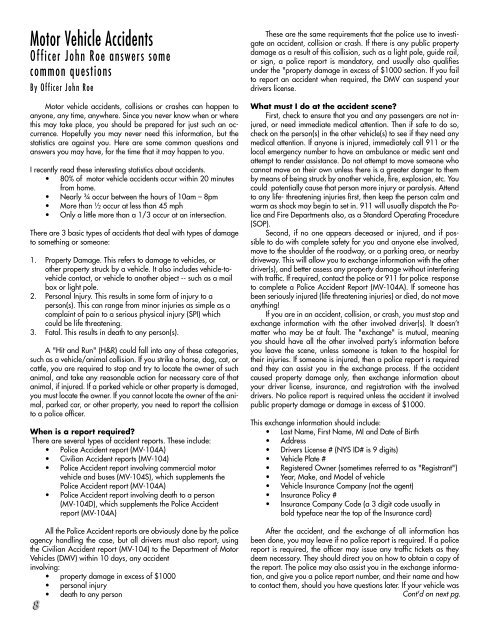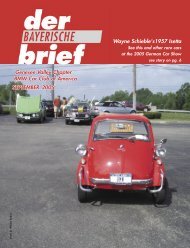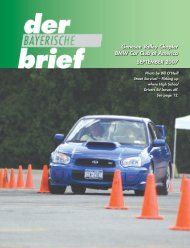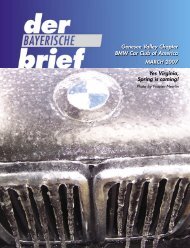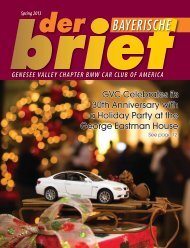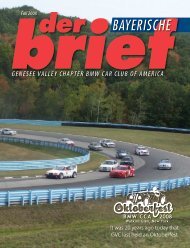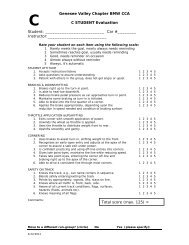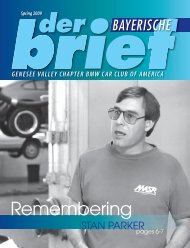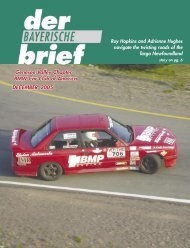Genesee Valley Chapter BMW Car Club of America JUNE 2007
Genesee Valley Chapter BMW Car Club of America JUNE 2007
Genesee Valley Chapter BMW Car Club of America JUNE 2007
You also want an ePaper? Increase the reach of your titles
YUMPU automatically turns print PDFs into web optimized ePapers that Google loves.
Motor Vehicle Accidents<br />
Officer John Roe answers some<br />
common questions<br />
By Officer John Roe<br />
Motor vehicle accidents, collisions or crashes can happen to<br />
anyone, any time, anywhere. Since you never know when or where<br />
this may take place, you should be prepared for just such an occurrence.<br />
Hopefully you may never need this information, but the<br />
statistics are against you. Here are some common questions and<br />
answers you may have, for the time that it may happen to you.<br />
I recently read these interesting statistics about accidents.<br />
• 80% <strong>of</strong> motor vehicle accidents occur within 20 minutes<br />
from home.<br />
• Nearly ¾ occur between the hours <strong>of</strong> 10am – 8pm<br />
• More than ½ occur at less than 45 mph<br />
• Only a little more than a 1/3 occur at an intersection.<br />
There are 3 basic types <strong>of</strong> accidents that deal with types <strong>of</strong> damage<br />
to something or someone:<br />
1. Property Damage. This refers to damage to vehicles, or<br />
other property struck by a vehicle. It also includes vehicle-tovehicle<br />
contact, or vehicle to another object -- such as a mail<br />
box or light pole.<br />
2. Personal Injury. This results in some form <strong>of</strong> injury to a<br />
person(s). This can range from minor injuries as simple as a<br />
complaint <strong>of</strong> pain to a serious physical injury (SPI) which<br />
could be life threatening.<br />
3. Fatal. This results in death to any person(s).<br />
A "Hit and Run" (H&R) could fall into any <strong>of</strong> these categories,<br />
such as a vehicle/animal collision. If you strike a horse, dog, cat, or<br />
cattle, you are required to stop and try to locate the owner <strong>of</strong> such<br />
animal, and take any reasonable action for necessary care <strong>of</strong> that<br />
animal, if injured. If a parked vehicle or other property is damaged,<br />
you must locate the owner. If you cannot locate the owner <strong>of</strong> the animal,<br />
parked car, or other property, you need to report the collision<br />
to a police <strong>of</strong>fi cer.<br />
When is a report required?<br />
There are several types <strong>of</strong> accident reports. These include:<br />
• Police Accident report (MV-104A)<br />
• Civilian Accident reports (MV-104)<br />
• Police Accident report involving commercial motor<br />
vehicle and buses (MV-104S), which supplements the<br />
Police Accident report (MV-104A)<br />
• Police Accident report involving death to a person<br />
(MV-104D), which supplements the Police Accident<br />
report (MV-104A)<br />
All the Police Accident reports are obviously done by the police<br />
agency handling the case, but all drivers must also report, using<br />
the Civilian Accident report (MV-104) to the Department <strong>of</strong> Motor<br />
Vehicles (DMV) within 10 days, any accident<br />
involving:<br />
• property damage in excess <strong>of</strong> $1000<br />
• personal injury<br />
• death to any person<br />
8<br />
These are the same requirements that the police use to investigate<br />
an accident, collision or crash. If there is any public property<br />
damage as a result <strong>of</strong> this collision, such as a light pole, guide rail,<br />
or sign, a police report is mandatory, and usually also qualifi es<br />
under the "property damage in excess <strong>of</strong> $1000 section. If you fail<br />
to report an accident when required, the DMV can suspend your<br />
drivers license.<br />
What must I do at the accident scene?<br />
First, check to ensure that you and any passengers are not injured,<br />
or need immediate medical attention. Then if safe to do so,<br />
check on the person(s) in the other vehicle(s) to see if they need any<br />
medical attention. If anyone is injured, immediately call 911 or the<br />
local emergency number to have an ambulance or medic sent and<br />
attempt to render assistance. Do not attempt to move someone who<br />
cannot move on their own unless there is a greater danger to them<br />
by means <strong>of</strong> being struck by another vehicle, fi re, explosion, etc. You<br />
could potentially cause that person more injury or paralysis. Attend<br />
to any life- threatening injuries fi rst, then keep the person calm and<br />
warm as shock may begin to set in. 911 will usually dispatch the Police<br />
and Fire Departments also, as a Standard Operating Procedure<br />
(SOP).<br />
Second, if no one appears deceased or injured, and if possible<br />
to do with complete safety for you and anyone else involved,<br />
move to the shoulder <strong>of</strong> the roadway, or a parking area, or nearby<br />
driveway. This will allow you to exchange information with the other<br />
driver(s), and better assess any property damage without interfering<br />
with traffi c. If required, contact the police or 911 for police response<br />
to complete a Police Accident Report (MV-104A). If someone has<br />
been seriously injured (life threatening injuries) or died, do not move<br />
anything!<br />
If you are in an accident, collision, or crash, you must stop and<br />
exchange information with the other involved driver(s). It doesn’t<br />
matter who may be at fault. The "exchange" is mutual, meaning<br />
you should have all the other involved party’s information before<br />
you leave the scene, unless someone is taken to the hospital for<br />
their injuries. If someone is injured, then a police report is required<br />
and they can assist you in the exchange process. If the accident<br />
caused property damage only, then exchange information about<br />
your driver license, insurance, and registration with the involved<br />
drivers. No police report is required unless the accident it involved<br />
public property damage or damage in excess <strong>of</strong> $1000.<br />
This exchange information should include:<br />
• Last Name, First Name, MI and Date <strong>of</strong> Birth<br />
• Address<br />
• Drivers License # (NYS ID# is 9 digits)<br />
• Vehicle Plate #<br />
• Registered Owner (sometimes referred to as "Registrant")<br />
• Year, Make, and Model <strong>of</strong> vehicle<br />
• Vehicle Insurance Company (not the agent)<br />
• Insurance Policy #<br />
• Insurance Company Code (a 3 digit code usually in<br />
bold typeface near the top <strong>of</strong> the Insurance card)<br />
After the accident, and the exchange <strong>of</strong> all information has<br />
been done, you may leave if no police report is required. If a police<br />
report is required, the <strong>of</strong>fi cer may issue any traffi c tickets as they<br />
deem necessary. They should direct you on how to obtain a copy <strong>of</strong><br />
the report. The police may also assist you in the exchange information,<br />
and give you a police report number, and their name and how<br />
to contact them, should you have questions later. If your vehicle was<br />
Cont'd on next pg.


